1. Introduction
 In 2002, five innovative technologists and entrepreneurs shared the vision of a uniquely diverse company teaming together, to add new levels of realism to computer simulated physics processes. They brought their skills and knowledge from around the world - from America, Germany, Egypt, India and America - and named their company based on their countries of origin: AGEIA Technologies, Inc.
In 2002, five innovative technologists and entrepreneurs shared the vision of a uniquely diverse company teaming together, to add new levels of realism to computer simulated physics processes. They brought their skills and knowledge from around the world - from America, Germany, Egypt, India and America - and named their company based on their countries of origin: AGEIA Technologies, Inc.
AGEIA is dedicated to delivering dynamic interactive realism to the ever demanding complexity of next generation games. Its first consumer product, called AGEIA PhysX, is the world's first dedicated physics engine and physics processor to bridge the gap between static virtual worlds and responsive unscripted physical reality. AGEIA PhysX allows developers to use active physics-based environments for a truly realistic entertainment experience.
- What is Physics?
 Physics is all about how objects in your game move and react. It's not just how things look, but how they behave. In many of today's games, objects just don't seem to act the way you'd want or expect. Most of the action is limited to pre-scripted or canned animations.
Physics is all about how objects in your game move and react. It's not just how things look, but how they behave. In many of today's games, objects just don't seem to act the way you'd want or expect. Most of the action is limited to pre-scripted or canned animations.
Even the most powerful weapons leave little more than a charred smudge on the thinnest of walls; and every opponent you take out falls in a strangely familiar way. Serious gamers are left with a fine game, but one with a missing sense of realism to make the experience truly immersive. Until now, only limited software physics has been integrated in games. That means physics computation has been handled by the general purpose CPU which is already burdened with the ever increasing demands of today's advanced games including game logic and AI.
Meanwhile, the highly specialized graphics processor is fully engaged with handling the rendering requirements of cinematic visuals at interactive framerates. As a result, physics in games has been limited to a few objects in a scene, one-off "effects" or visual trickery that just mimics real physics. Now, the AGEIA PhysX Processor promises to deliver computing horsepower necessary to enable true, advanced physics in games.
- What is Ageia PhysX?
Delivering physics in games is no easy task. It's an extremely computing-intensive environment based on a unique set of physics algorithms that require tremendous amounts of mathematical and logical calculations supported by massive memory bandwidth. Simply put, it requires the AGEIA PhysX processor: a specialized accelerator dedicated solely to delivering rich immersive physical gaming environments with features such as:
- Explosions that cause dust and collateral debris
- Characters with complex, jointed geometries for more life-like motion and interaction
- Spectacular new weapons with incredible effects
- Cloth that drapes and tears the way you would expect it to
- Dense smoke & fog that billow around objects in motion

According to Ageia, the only way to get real physics with the scale, sophistication, fidelity and level of interactivity that dramatically alters your entertainment experience is with the AGEIA PhysX processor, which was developed from day one to accelerate the highly specialized physically based simulations.
- Which games are supported?
Ageia has a long list of "future"games that will support a PhysX card. AGEIA PhysX users can find the following titles available now:
- Bet on Soldier: Blood Of Sahara
- Bet on Soldier: Blood Sport (Patch)
- CellFactor: Combat Training
- City of Villains (Patch)
- Dark Physics
- Tom Clancy's Ghost Recon Advanced Warfighter
2. ASUS PhysX P1
 With the ASUS PhysX P1 Card powered by the AGEIA PhysX processor, things don't just look real, they act real and feel real. Prepare to be shocked by stunning, massively destructible buildings and landscapes, explosions that cause collateral damage, lifelike characters with spectacular new weapons, realistic smoke, fog and oozing fluids. All are now possible with the ASUS PhysX P1! Asus has a special site that demonstrates the PhysX major advantages.
With the ASUS PhysX P1 Card powered by the AGEIA PhysX processor, things don't just look real, they act real and feel real. Prepare to be shocked by stunning, massively destructible buildings and landscapes, explosions that cause collateral damage, lifelike characters with spectacular new weapons, realistic smoke, fog and oozing fluids. All are now possible with the ASUS PhysX P1! Asus has a special site that demonstrates the PhysX major advantages.
- Features
- The Hottest 3D Game: Ghost Recon Advanced Warfighter bundled in Ghost Recon Edition
- High 128M memory size
- High Speed DDR3 memory interface: Support DDR3 memory delivers smoother game play via onboard acceleration of dynamic physics geometry and simulation objects.
- Stylish and High performance heatsink to cool down the heat effectively
- Powered by AGEIA PhysX Processor
- Massively Parallel Physics Architecture: Highly tuned multi-core complex optimized for dynamic, large-scale physics processing. Accelerates real-time physical motion and interaction at a scale and quality far beyond what's possible with CPU or GPU
- Universal Continuous Collision Detection: Enables entire environments to be interactive and destructible with massive scale of collisions and response between fast moving objects
- Physical smart particle technology: Empowers tens of thousands of realistic smart particle calculations of volume, density and pressure for pervasive fluids, smoke rain and debris
- Complex Object Physics System: Drives physics processing beyond a few primitive shapes and simple effects to more accurate and realistic representations of physical objects and interactions
- Scalable Terrain Fidelity: Delivers physical landscape accuracy and genuine surface reactions for true environmental experiences
- Dynamic Gaming Framework: Flexible Ageia PhysX hardware architecture provides an upgrade path to tomorrow's powerful feature and performance enhancement via software
Models Available
- ASUS PhysX P1 Ghost Recon Edition:
PCI Interface, PhysX, 128M DDR3, w/ Ghost Recon Advanced Warfighter
- ASUS PhysX P1: PCI Interface, PhysX, 128M DDR3
- Specification
Processor Type |
AGEIA™ PhysX™ |
Bus Technology |
32-bit PCI 3.0 |
Memory Interface |
128-bit GDDR3 |
Memory Capacity |
128MB |
Memory Bandwidth |
12Gbytes/sec. |
Memory Clock |
733MHz |
Peak Instruction Bandwidth |
20 Billion Instructions/sec |
Sphere-Sphere collision/sec |
530 Million max |
Convex-Convex (Complex) collisions/sec |
533,000 max |
Adaptor/Cable Bundled |
Power Cable |
Software Bundled |
Asus PhysX P1 GRAW Edition:
Ghost Recon Advanced Warfighter
Cell Factor
SwitchBall
Demo Asus Driver
Asus PhysX P1:
SwitchBall demo
Asus Driver |
3. Retail package
Asus PhysX P1 comes in a smaller than usual VGA card box. Its retail price ranges from US$240 to US$270, which places it in the same price range as the Nvidia 7900GS. It would be true to say that anyone who will spend US$250 for this card is more than likely going to be an enthusiast user.

The retail package includes:
- Asus PhysX P1 card
- Power Cable
- Driver CD
- Ghost Recon Advanced Warfighter Full Edition CD
- Cell Factor Demo CD
- SwitchBall Demo CD

The card itself can be characterized as mid-sized. You can see the Asus fan on the front, cooling the Ageia PhysX chipset (click for high-res image):
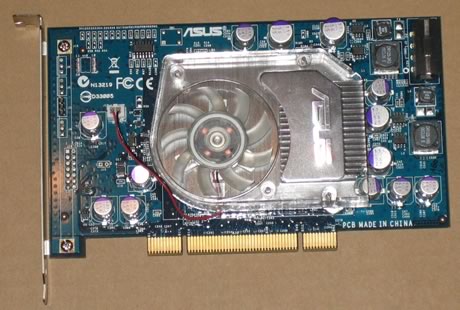
On the back, we find the card's ID and #SN
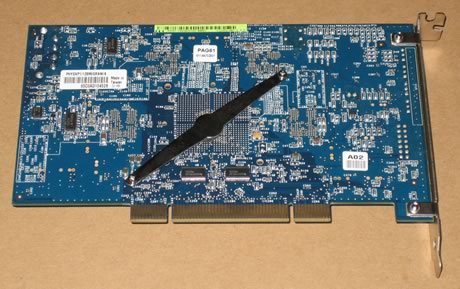
The PhysX AGEIA logo is on the mounting plate.

Since the PCI bus doesn't offer enough current to power the card, you need to connect an external power source.

Removing the heatsink, we can see the PhysX ageia chipset:

4. Installation
After installing the card in a free PCI bus slot, Windows prompts for the drivers (unknown PCI device). We used the latest available driver pack ( v2.51) for all tests. The installation wizard is easy and shortly after rebooting, you can begin exploring what the Asus PhysX P1 card has to offer.


After rebooting, you can check the various properties of the AGEIA PhysX card, like the installed Windows driver and PhysX engine:

There is a demo included that works both with the card installed (hardware) or not (software mode):

A screenshot from the demo is shown below. You hit a pack of boxes with balls and see how each box reacts.

The CPU load was around 53%:

Disabling the PhysX card (software mode), the CPU load increased up to 73% (max):
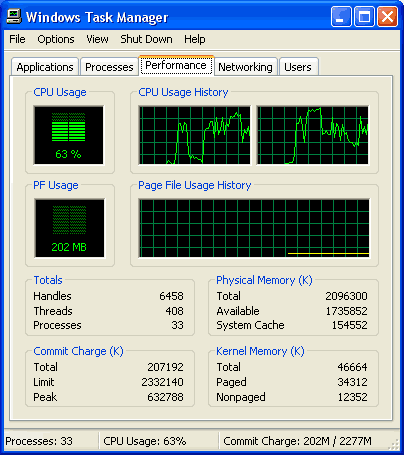
The card can also be reset or can perform extended diagnostics,

that validates your card is working just fine.

5. CellFactor - Page 1
 PhysX Owners can now get in on the action with the hot new hardware physics accelerated title: CellFactor: Combat Training from Artificial Studios and Immersion Games. All you need is a PhysX accelerator and a decent gaming rig, and you're ready to get fragging. This beta demo is both multiplayer and single player enabled with customizable bots. It includes one level for play plus Reality Builder software for creating your own levels.
PhysX Owners can now get in on the action with the hot new hardware physics accelerated title: CellFactor: Combat Training from Artificial Studios and Immersion Games. All you need is a PhysX accelerator and a decent gaming rig, and you're ready to get fragging. This beta demo is both multiplayer and single player enabled with customizable bots. It includes one level for play plus Reality Builder software for creating your own levels.

Note: CellFactor Beta R36 includes a number of performance and file management improvements.

After downloading CellFactor R36, we used the built-in installer and after a while, we saw two icons on our desktop.

The final CellFactor version is expected to arrive in 2007. The game's engine would require an AGEIA PhysX card installed in order to run. Even the beta we tried warned us that it would not run if we didn't have an Ageia PhysX card on board. However, users can test CellFactor by adding "EnablePhysX=false" at the end of the game's shortcut.


The game uses HDR, that gives a huge performance hit overall. For our review, we tried to find an acceptable frame rate at 1024x768 with mostly basic visual improvements enabled. In the game options, we found the selection box where Ageia PhysX acceleration is by default enabled and grayed out, Physics acceleration is on:

We could also disable physics acceleration using the above mentioned command parameter when running CellFactor so that it operates in software rendering mode.
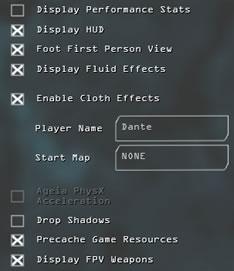
6. CellFactor - Page 2
The game in general was smooth without HDR enabled on our test PC (Core2Duo 6600, 2GB RAM and MSI 7600GT). The most impressive effects are shown below. And while you can get a quick snap of the in game action, you really need to see it in real life action. After shooting a device, it creates a warp effect, where all nearby items are "sucked in ", like a black hole. Notice the liquid effects too:





After getting a booster, the surroundings looks like you are warping. Flying high, while it lasts:



Despite the AGEIA PhysX P1 acceleration, there were times when the action seemed to pause for what felt like 1/2 of sec, due to the high number of explosions. The game was playable without PhysX acceleration enabled, however there were times when the FPS dropped down to 1~2. The average FPS with AGEIA PhysX enabled was 35 fps (as fraps reported), while with the PhysX card removed, around 11FPS. We do believe that Cellfactor shows the true potential of the Ageia PhysX card, and will be a big hit when it hits retail (around Q1 of 2007).
7. GRAW - Page 1
 Take on the streets of Mexico City with the PhysX advantage! Intense, realistic damage effects bring the battle to you with unrivaled detail and precision.
Take on the streets of Mexico City with the PhysX advantage! Intense, realistic damage effects bring the battle to you with unrivaled detail and precision.
Combining the advantages of next-generation console technology with future military technologies, Tom Clancy's Ghost Recon Advanced Warfighter™ includes many groundbreaking features, including the Cross-Com, a communication device powered by satellite technology, which will deliver complete battlefield awareness in the chaos of the Urban warfare.
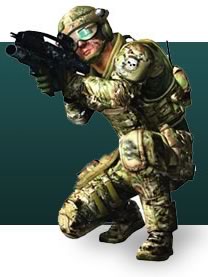 AGEIA PhysX support comes standard with Tom Clancy's Ghost Recon Advanced Warfighter and is used to add a higher level of detail to effects throughout the game. While playing, you'll be sneaking through the streets of Mexico City attempting to avoid sniper fire and numerous nests of enemy combatants. Each enemy shot will cause fragments and particles to fly around, adding to the intensity and detail of the fire fight.
AGEIA PhysX support comes standard with Tom Clancy's Ghost Recon Advanced Warfighter and is used to add a higher level of detail to effects throughout the game. While playing, you'll be sneaking through the streets of Mexico City attempting to avoid sniper fire and numerous nests of enemy combatants. Each enemy shot will cause fragments and particles to fly around, adding to the intensity and detail of the fire fight.
Owners of the AGEIA PhysX accelerator should get the most recent drivers and game patches for optimum performance in this game.
There is no indication inside the game that PhysX mode is enabled, we assume that this is done automatically. Don't be afraid if you see AGEIA Drivers installed even if you don't have the card, the game uses Ageia SDK so they are needed. Of course, you can try removing them, GRAW may work as well.
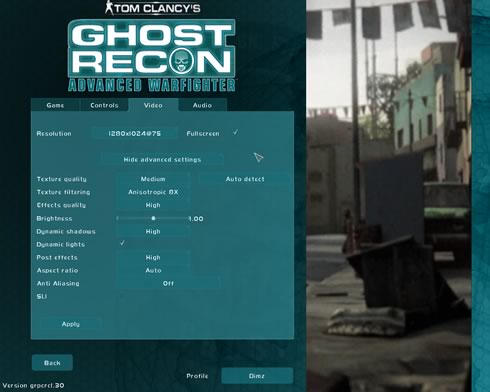
In GRAW, Ageia PhysX effects are not so impressive as they were in Cellfactor. In fact, there are differences, like when shooting a wall, more pieces are blown to smithereens:
Without Ageia PhysX
With Ageia PhysX 
Above, more flashes and bits flying off are produced when shooting walls, floors and in general buildings, roads. What about explosions? Here, things are better. Let's watch a sequence of a wall explosion:
Without Ageia PhysX 
With Ageia PhysX 
The difference here is stunning. The explosion is better with more flares and bigger fire/flashing coming out the impact point...
8. GRAW - Page 2
The explosion without AGEIA PhysX looks very "plain"..
Without Ageia PhysX 
The explosion fire stops, there's some smoke coming from the impact point
.With Ageia PhysX 
However, with Ageia PhysX, more visual effects are offered.
Without Ageia PhysX 
With Ageia PhysX 
Without Ageia PhysX 
With Ageia PhysX 
9. GRAW - Page 3
The smoke continues, however AGEIA PhysX continues to offer more wall fragments flying around and smoke flashes:
Without Ageia PhysX 
With Ageia PhysX 
Ageia PPU continues to calculate and offer more visual effects:
Without Ageia PhysX 
With Ageia PhysX 
The smoke is there even without Ageia PhysX, but with Ageia it gives more detail, more realism:
Without Ageia PhysX 
With Ageia PhysX 
10. GRAW - Page 4
The three following frames show that without AGEIA PhysX, the smoke is almost vanished. However, with Ageia PhysX enabled, smoke is present and more effects are offered:
Without Ageia PhysX 
With Ageia PhysX 
Without Ageia PhysX 
With Ageia PhysX 
Without Ageia PhysX 
With Ageia PhysX 
The scene with AGEIA PhysX enabled lasts at least 2-3 more frames, since smoke and wall fragments continue to fly around and fall from above...
11. Reality Mark - Page 1
 AGEIA RealityMark™ is a new tool which demonstrates the feature and performance value of AGEIA PhysX in a physics-intensive gameplay environment. It’s designed to illustrate how next-generation game design uses the power of the PhysX processor to enable leading-edge, physically interactive gameplay elements which were not possible until now.
AGEIA RealityMark™ is a new tool which demonstrates the feature and performance value of AGEIA PhysX in a physics-intensive gameplay environment. It’s designed to illustrate how next-generation game design uses the power of the PhysX processor to enable leading-edge, physically interactive gameplay elements which were not possible until now.

RealityMark is based on a version of CellFactor: Combat Training from Artificial Studios and Immersion Games. It utilizes a pre-scripted gameplay sequence much like a time demo to compare in-game performance of hardware and software PhysX. The scripted sequence is played once with the PhysX processor enabled and a second time with it disabled to determine the relative performance of each. It then returns the results in terms average Frames Per Second (FPS).
The gameplay sequence records a player interacting with elements such as tearing cloth and thousands of rigid bodies such as boxes, pipes and other containers. Future versions of RealityMark will add even more computationally intensive physics elements.
 As with any tool of this nature, results of both tests will vary from system
to system depending on the specific hardware configuration. As Ageia comments "...Buyers should consult other sources of information to evaluate the actual
performance of systems they are considering purchasing..."
As with any tool of this nature, results of both tests will vary from system
to system depending on the specific hardware configuration. As Ageia comments "...Buyers should consult other sources of information to evaluate the actual
performance of systems they are considering purchasing..."
As we all understand, this tool is not a means of determining the raw performance of the PhysX
Accelerator, but rather is designed to provide a useful comparison under
the specific conditions in this particular title and under these specific
physics-intensive circumstances.
The test results may or may not reflect the relative performance of the
PhysX processor in systems with different hardware or software
capabilities or configurations, and results will differ depending on the
physics demands of the particular game being played.
- AGEIA RealityMark Features
There are physics interaction levels that vary from a small number of rigid
body object collisions to many thousands, including some impact with
complex cloth objects. Such increases in physics activity and associated
calculations can occur rapidly. This happens during explosion sequences
where the demand for physics calculations immediately increases.The sequence includes physically simulated cloth which is deformable
and can be torn realistically. The cloth interacts with both player weapons
and other objects in the battlefield. Visualization leverages DirectX 9.0 graphics features such as High
Dynamic Range (HDR) Lighting and dynamic shadows to best
approximate the graphical demands of this title and most other DirectX 9.0
titles.
- Comparing Non-Accelerated vs. Hardware-Accelerated PhysX
Every effort has been made to allow for a fair comparison of PhysX
simulation in a software-only environment as compared to a hardware
implementation of PhysX.
Due to the complex nature of game physics, subtle differences can be
seen during the two runs of the test. These differences are essentially
due to the loss of accuracy when performance drops below that needed
for real-time simulation.
Physic simulation requires the solution of many complex equations to
determine the change of state of the game objects during a fixed duration
of time, also known as a ‘time step’. Should these calculations take too
long to accomplish, the physics subsystem will lag behind the game’s
global time. One way to adjust for this is to increase the size of the time
step in each simulation iteration. This allows the objects to keep up with
real-time, but greatly increases the chances that some object interactions
or collisions will be completely missed. This can be seen during the nonaccelerated
simulation on some systems, as some objects fly through the
cloth banner without causing tearing.

During testing in AGEIA test labs, it’s been determined that all major
components of today’s high-performance PC can impact the actual
performance measures. This includes, but isn’t limited to, CPU speed,
number of processor cores, GPU speed and system memory. Each of
the core elements of the Gaming Power Triangle, the PPU (Physics
Processing Unit), CPU, and GPU, has important roles to play to enable optimal gaming. It is recommended that tests be run several time to determine the average
results for your system and achieve the most accurate possible result.
There will be some variance in the measured frame rate between different
runs of the test due to the complex balance of the PPU, CPU and GPU
operations.
- System Requirements For RealityMark
- AGEIA PhysX Accelerator with latest drivers (2.5.1 or later required)
- Microsoft Windows ® XP 32-bit or 64-bit
- 1GB System RAM or higher
- At least 1 GB free hard disk space
- Intel® Pentium® 4 or Celeron Processor, 1.5GHz or higher OR AMD Athon XP™ 2400+ or higher
- DirectX 9.0 graphics adapter with 128MB RAM or higher
12. Reality Mark - Page 2
- Installation
AGEIA RealityMark will install and run on systems without a PhysX
accelerator card installed. On such systems the PhysX hardwareaccelerated
test run is skipped and the software-only test is executed. The
final result will show the accelerated score from an average gaming PC
with a hardware PhysX accelerator installed (not your system) and the
actual software-only result from the test system.
The default hardware- accelerated result will always register at 35.23 FPS for comparison
purposes. It should be noted that accelerated PhysX performance has
been measured at 45 fps+ for higher performance systems.
Users can download Ageia RealityMark for free. It should be noted that AGEIA RealityMark does not include the
CellFactor: Combat Training Demo, which can be downloaded seperatly. The download size is over 370MB so have some patience while its coming at your PC. Its also advised to get the latest available drivers set. The installation creates a separate directory for storing the Reality Engine
files, to prevent any accidental conflict with the game engine files used by
CellFactor. The PhysX SDK and system driver files are shared with other
PhysX applications. Version 2.5.1 SDK is used by RealityMark, and will
install the associated runtime system software if the user has the same or
older software already on their system.
The installation procedure simple, just follow the setup wizard,

the default package comes with Ageia PhysX 2.5.1 drivers, for our tests we used both 2.5.1 and 2.6.0, you need to remove previous drivers in order to upgrade:

the updating procedure continues,

and finally its over.

The Ageia PhysX properties box gives us information about Windows driver and installed PhysX engines:

Lastly, we have to note that RealityMark installs xFire client, without asking you...

- Performance
It's time we run for the first time RealityMark, the ageia logo appears,

and PhysX logo appears also.

The Benchmark is loading, while we get the information that we run it *without* hardware acceleration, we remove Ageia PhysX card for the first run:

The Benchmark starts, we see the action from above, a new player jumps in the action, firing granades, so many things are keeping exploded, while initial the frame rate is around 30 fps, then it drops at 3.45, you cannot feel the in-game action:

The benchmark lasts around 15secs, at the end we get a comparison with and without hardware PhysX acceleration, note that in case you don't have a PhysX card installed, RealityMark will use 35.23 FPS as comparison, in our case we got only 2.85 FPS.
Without PhysX

A second round of the benchmark gave us slightly higher score,
Without PhysX
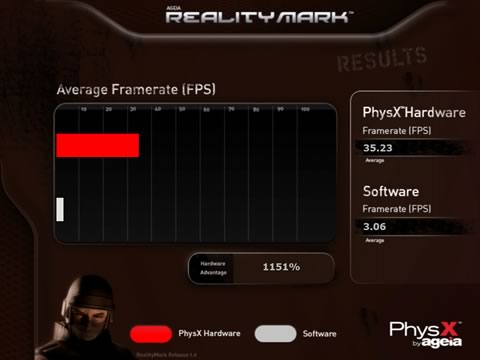
In case you have a PhysX card enabled, the action is much better, smooth and with nice effects, the benchmark will run both modes and give you another comparison indication, notice that our PhysX hardware score (43.77), was better than what Ageia uses as default,
With PhysX 2.5.1

With PhysX 2.6.0

Below is a summary of our test results, with and without PhysX card and with 2.5.1 and 2.6.0 driver package:
Mode |
2.5.1 Drivers |
2.6.0 Drivers |
Hardware |
43.71 |
44.17 |
Software |
3.09 |
3.43 |
As we can see, the Benchmark shows that without PhysX card, its nearly impossible to have an acceptable frame rate, even with a poweful PC setup, like ours:
- Intel Core2Duo 6600 (2.4GHz @ 3.150)
- 2GB DDR2
- MSI 7600GT
The new released 2.6.0 driver package also seems to improve performance, even by a little margin.
13. Conclusion
 AGEIA PhysX is the first dedicated Physics Engine that hits the market in 2006. Ageia has a good selling point, aiming at enthusiast users who want to add extra realism to their gaming experience. Looking at the blurb, Ageia PhysX looks and feels like a great idea, however, we have to see if the final product fulfills the promise.
AGEIA PhysX is the first dedicated Physics Engine that hits the market in 2006. Ageia has a good selling point, aiming at enthusiast users who want to add extra realism to their gaming experience. Looking at the blurb, Ageia PhysX looks and feels like a great idea, however, we have to see if the final product fulfills the promise.
Asus and BFG are two manufacturers that sell PhysX enabled cards on the market. Both manufacturers use the same design, with different cooling systems (both fan based).

Passing to the installation part, no problems here. Just remember to grab the latest driver pack from the Ageia website. The supported game list is, for now, kind of small, with only GRAW supporting Ageia PhysX out-of-the-box. Asus bundles it in their retail package. CellFactor is another impressive technology demo that fully showcases Ageia PhysX card abilities and opens a window for the retail version, coming early in 2007.

In both mentioned games, the PhysX card adds extra physics and gaming experience for its users. While you can see the difference, the issue is that if you can almost feel it. There's more debris flying out after an explosion and more fire and liquid effects. However we think that in 3D person shooter games, where the action is super fast, such things may not be noticed during the thick of the action. Certainly, it will offer more eye pleasant effects and add to the realism. GRAW has very minor visual differences, while CellFactor cannot be played without a PhysX card (at least at a respectable frame rate).

Both Asus and BFG sell their PhysX cards at the price range of US$240~270, which doesn't make them cheap. What you get with the retail package (the card, GRAW retail version, and 3 CDs with Demos) is not worth the price, especially since it doesn't accelerate or boost your current graphics card setup. You can just as easily add a second card to your system (either SLI or Crossfire) will boost frame rates in 3D person shooters or enable higher AA/AF rendering modes.

As so many others have already stated, Ageia needs a "killer" game that will boost and unleash all the abilities of PhysX chipset. After all, games are driving the hardware industry, not the other way around.
Overall, we advise users to keep their money and wait until Physics technology matures. Don't forget that already, ATI and Nvidia claim that their GPUs can do physics as well, and that there is no need for an extra PPU card in your system. If that claim is true, only time will tell. We hope that Ageia will continue developing innovative products which will bring more realism to our gaming world.